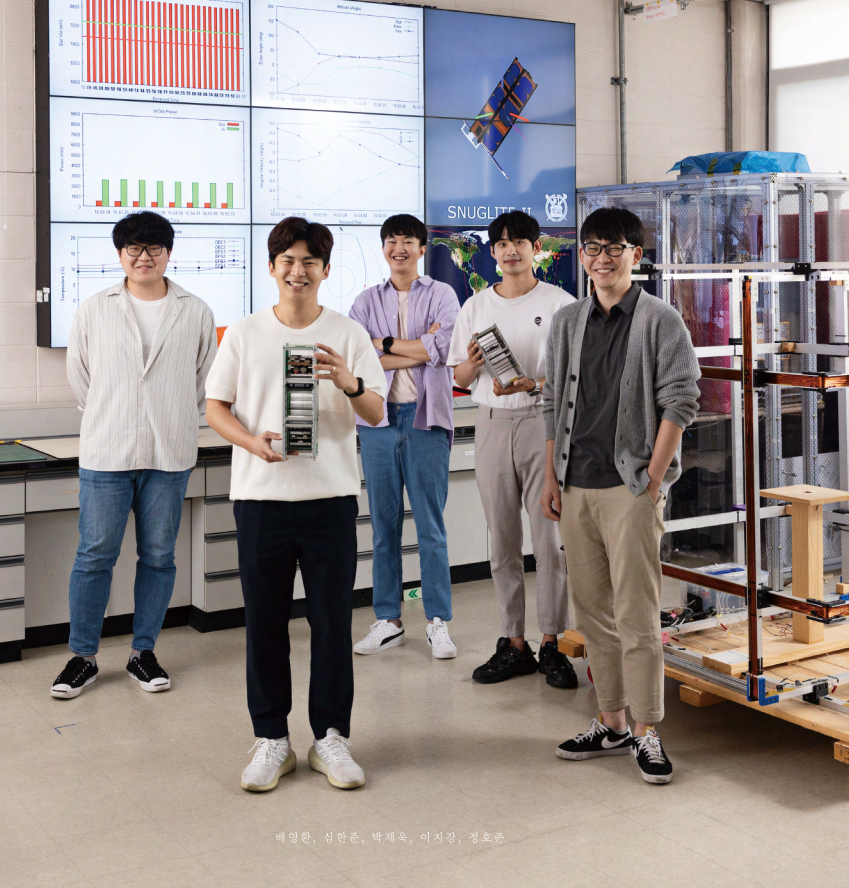Interview
A small dream launched
into space
GNSS laboratory, Department of Aerospace Engineering

From left) Yonghwan Bae, Hanjoon Shim, Jaeuk Park, Jikang Lee, Hojoon Jeong
On its second attempt, Nuri, the nationвҖҷs first domestically built space rocket, was successfully launched into orbit on June 21. Carried into space by the homegrown launch vehicle were four small cube satellites, one of which was SNUGLITE-в…Ў, developed by the Global Navigation Satellite System (GNSS) research team at Department of Aerospace Engineering of SNU. The cube satellite SNUGLITE-в…Ў was safely released from the rocket and successfully communicated with its counterpart on Earth. We met with the key players who made this happen.
With the unparalleled passion of five young scientists
SNUGLITE-в…Ў is a cube satellite, developed by the GNSS research team at Department of Aerospace Engineering of SNU, which consists of five doctoral students working under the guidance of Changdon Kee, Professor at Department of Aerospace Engineering. They literally do everything related to SNUGLITE-в…Ў, including design, development, assembly, manufacturing, and even acknowledgement of information on the status of the satellite.
вҖңWe divided the roles within the team, such as the communication system, thermal structural analysis, optical system, and structure design for solar panel deployment. As team leader, I was in charge of not only project management, but also other tasks involving overall system configuration management, attitude control, flight software, and final assembly and verification. Given the limited manpower and other non-project assignments, each member had to assume multiple tasks. We all have invested considerable amounts of time and effort in getting things done. The project, though demanding, was of great significance in that it allowed us to have first-hand experience with the entire process of cube satellite production.вҖқ -Hanjoon Shim
SNUGLITE-в…Ў is an upgraded version of SNUGLITE-в… , which was selected at the 5th CubeSat Contest held in 2019. We have devoted ourselves to this project for more than three years, and we sincerely prayed for success. The estimated separation date of SNUGLITE-в…Ў, which was to be ejected following the ones created by Chosun University and KAIST, was June 3. The GNSS research team could not sleep at all the night before the D-day and waited for the satellite signal to arrive.
вҖңWe all gathered here at the laboratory, and silence prevailed. Around three in the morning, we heard hissing sounds three times, meaning that SNUGLITE-в…Ў was alive in space. As if by appointment, all of us stood up and shouted, enjoying the festive mood. Our eyes were filled with tears of joy.вҖқ -Hojoon Jeong, Jikang Lee
Launch into the future with our dream loaded
SNUGLITE-в…Ў is tasked with monitoring the EarthвҖҷs atmosphere using a high-precision GPS carrier. Unlike other cube satellites, our satellite is equipped with ultra-compact and ultra-precise GPS receivers to collect weather data and forecast the weather in a more accurate manner.
вҖңSNUGLITE-в…Ў is a 3U CubeSat, measuring 10cm in width and length and 34cm in height, while weighing only 3.15kg. A range of devices, such as an optical camera and a precision GPS attitude determination module, are mounted on it. What is also noteworthy is that the satellite carries three ultra-precision mm class carrier-phase dual-frequency GPS receivers. Since no GPS receiver manufacturers are available in Korea, we collaborated with a medium-sized enterprise and jointly developed the first GPS receiver for space. Compared to widely-used foreign GPS receivers, our receiver is smaller and shows better performance, making it possible to predict weather more precisely.вҖқ -Yonghwan Bae
Although it has been confirmed that the domestically developed GPS receivers, which are mounted on SNUGLITE-в…Ў, function properly to provide location information, we have difficulty receiving satellite status information, which we believe is part of the research process. The GNSS research team continues to work hard to address this challenge.
вҖңProfessor Kee repeatedly says, вҖҳThe history of space exploration has been a string of failures, so we should learn from failures and keep moving to develop into well-respected and competent researchers who do their utmost.вҖҷ We plan to develop more advanced and sophisticated cube satellites than SNUGLITE-в…Ў. As a kid, I never imagined that I would see the launch of a homegrown rocket. Likewise, it will not be long before our dream becomes a reality.вҖқ -Jaeuk Park, Hanjoon Shim

